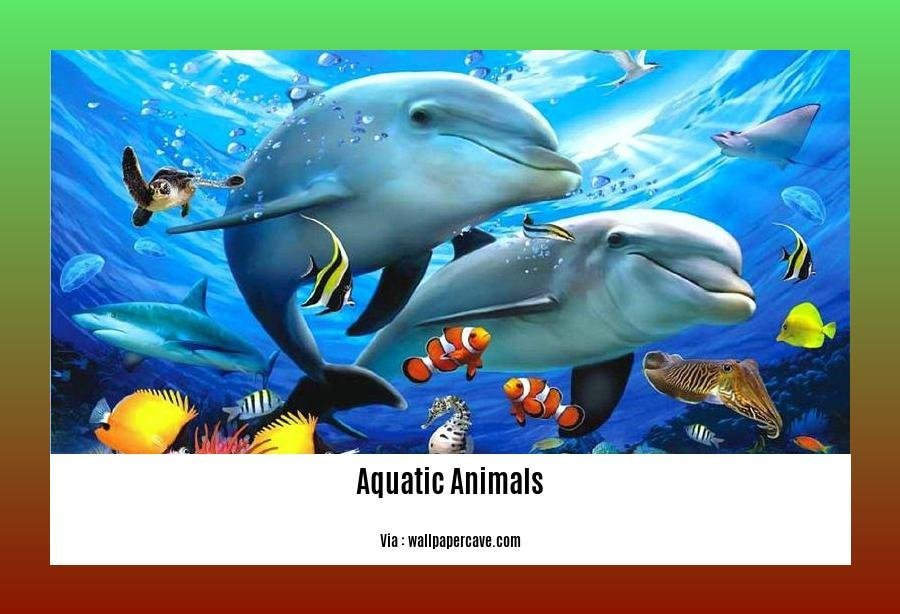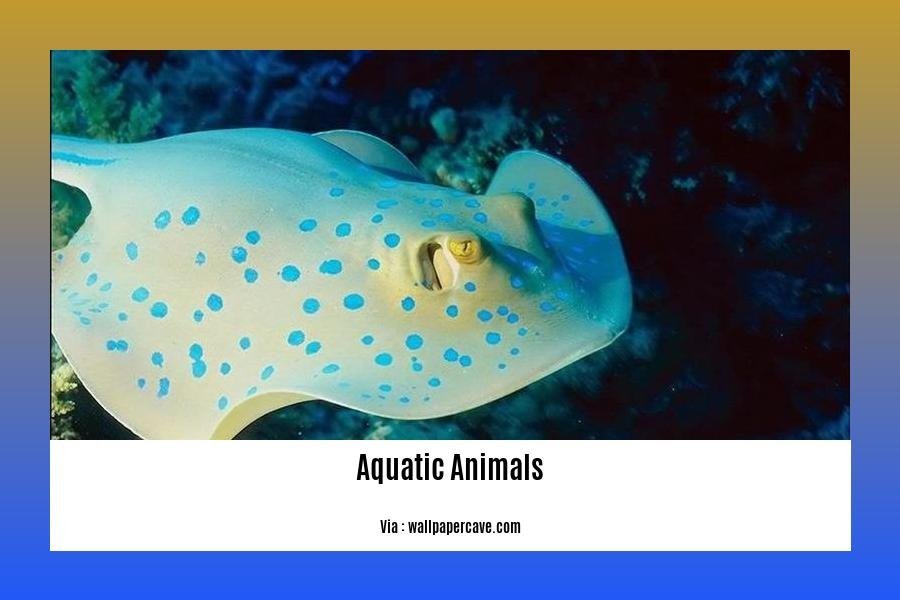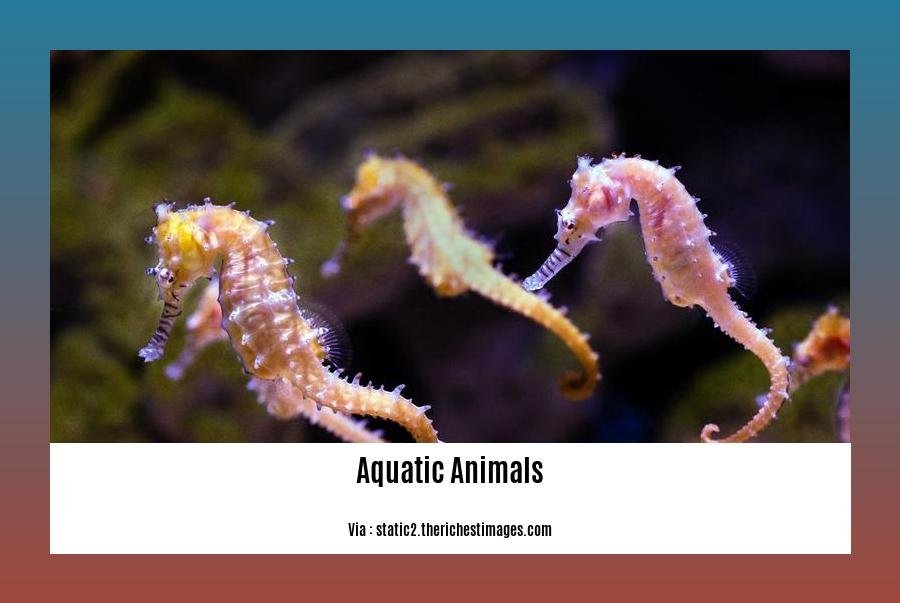Dive into the fascinating world of aquatic animals and discover a treasure trove of fun and fascinating facts that will leave you amazed. From the mysterious depths of the ocean to the tranquil waters of rivers and lakes, these incredible creatures have adapted to survive and thrive in their underwater habitats. In this article, we will uncover some lesser-known secrets about aquatic animals that will ignite your curiosity and deepen your appreciation for the wonders of marine life. Get ready to embark on a captivating journey as we reveal the enchanting and surprising aspects of the aquatic world.
Key Takeaways:
- A wide range of ocean animals, from turtles to whales, have fascinating and interesting facts waiting to be discovered.
- These aquatic animals have diverse habitats and behaviors, making them intriguing subjects of study.
- Conservation status information is available for these animals, highlighting the importance of their protection and preservation.
- The Oceana website provides more detailed information on these aquatic animals and can be a valuable resource for further exploration.
Fun Facts About Aquatic Animals

Introduction:
Welcome to the captivating world of aquatic animals! Join me on a thrilling adventure as we explore the depths of the ocean and uncover some fascinating fun facts about these extraordinary creatures. From turtles to whales, the marine world is filled with incredible adaptations, behaviors, and ecosystems that will leave you in awe. So, without further ado, let’s dive right in!
Dolphins: Intelligent and Playful Marine Mammals
Dolphins, known for their intelligence and playful nature, have a few secrets up their sleeves. Did you know that dolphins are excellent communicators? They use a series of clicks, whistles, and body movements to convey messages to each other. It’s like they have their own language!
Another interesting fact about dolphins is their remarkable problem-solving skills. They have been observed using tools and tactics to catch their prey. For example, some dolphins will create a ring of bubbles around a school of fish, effectively trapping them and making them easier to catch. Talk about clever hunters!
Seahorses: Curious Creatures with a Unique Reproduction Process
Seahorses, with their whimsical appearance, have a reproduction process like no other. Unlike most animals, it is the male seahorse that gets pregnant and gives birth to the young ones. The female deposits her eggs into the male’s pouch, where they are fertilized and nurtured until they’re ready to hatch. It’s truly a role reversal in the underwater world!
Additionally, seahorses have the remarkable ability to change colors to blend in with their surroundings, helping them hide from predators or sneak up on their prey. They’re like underwater chameleons!
Octopuses: Masters of Disguise and Escape Artists
The intriguing octopus possesses exceptional survival skills. Their ability to change color and texture enables them to seamlessly blend into their surroundings, making them masters of disguise. They can even mimic the appearance of other animals or objects, fooling both predators and prey.
But that’s not all! Octopuses are also incredible escape artists. With their soft bodies and innate problem-solving abilities, they can squeeze through tiny gaps, open jars, and even unscrew lids. They’re like the Houdinis of the ocean!
Sharks: Apex Predators with an Incredible Sense of Smell
Sharks have a reputation as fearsome predators, but did you know that they have a sixth sense? Sharks possess an incredible sense of smell, allowing them to detect a drop of blood in the vast ocean from miles away. It’s like having a built-in GPS for finding food!
Another interesting fact about sharks is their diverse range of tooth structures. From sharp, triangular teeth for catching and cutting prey to flat, plate-like teeth for crushing shells, each species of shark is uniquely equipped for its specific diet. It’s like having a versatile set of tools in their mouths!
Conclusion:
There you have it, a glimpse into the mesmerizing world of aquatic animals and their remarkable fun facts. From dolphins’ intelligence to seahorses’ unique reproduction process, octopuses’ disguise talents, and sharks’ incredible sense of smell, these creatures never cease to amaze us. So, the next time you find yourself near the ocean, remember to appreciate the wonders that lie beneath the surface. Happy exploring!
*Note: For more in-depth information on these and other fascinating aquatic animals, be sure to visit the Oceana website, where you can discover a wealth of knowledge about their habitats, behaviors, and conservation status.
Here are some interesting facts about freshwater fish that you might not know:
– freshwater fish facts Did you know that some freshwater fish can live for over 20 years?
– freshwater fish information Discover the amazing variety of species and habitats of freshwater fish.
– fun facts about animals in the ocean Explore fascinating facts about unique ocean creatures and their incredible abilities.
Unusual and Fascinating Reproductive Strategies in Aquatic Animals
Reproductive strategies in aquatic animals are as diverse as the creatures themselves. From unique mating rituals to extraordinary methods of fertilization, these underwater beings never cease to amaze us. In this article, we will dive into the captivating world of unusual and fascinating reproductive strategies in aquatic animals.
1. Diversity of Reproductive Systems
Aquatic animals display a wide variety of reproductive systems that differ greatly from those of their terrestrial counterparts. While land-dwelling animals typically rely on internal fertilization, aquatic creatures have developed alternative strategies. Some aquatic animals practice internal fertilization, either with or without mating, while others depend on external fertilization. The astonishing range of reproductive systems in aquatic animals is vividly depicted in Figure 1.1 of a research published in Springer[^1].
2. Hermaphroditism: Nature’s Dual-gender Phenomenon
Hermaphroditism, a notable feature prevalent in many aquatic animals, both intrigues and surprises us. Certain fish species possess the remarkable ability to change their gender, while numerous invertebrates exhibit hermaphroditism[^1]. These hermaphroditic animals possess both male and female reproductive organs, enabling them to engage in self-fertilization or mate with others. An intriguing example of hermaphroditism is the nematode Caenorhabditis elegans, which undergoes a type of parthenogenesis, allowing for self-fertilization[^1].
3. Factors Affecting Reproduction: Nature’s Balancing Act
Reproduction in aquatic animals is influenced by a myriad of factors, both internal and external. Internal factors such as genetics and hormonal regulation play a crucial role in reproductive processes, while external elements like diet, temperature, and light also impact the reproductive success of these mesmerizing creatures[^2]. A comprehensive understanding of the genetic basis and underlying mechanisms of aquatic animal reproduction is vital for the successful production of seeds in aquaculture.
4. Assisted Reproductive Technology: A Helping Hand for Aquatic Life
Assisted reproductive technology (ART) is increasingly playing a pivotal role in the conservation and propagation of aquatic animals within the realm of aquaculture. Cryopreservation of gametes is an example of an ART that offers flexibility in terms of embryo/juvenile production and the preservation of elite broodstock and endangered species[^2]. By facilitating the sustainable management of aquatic ecosystems, ART contributes significantly to the conservation efforts and overall well-being of these captivating aquatic species.
Key Takeaways:
- Aquatic animals exhibit a diverse array of reproductive systems, different from those of their terrestrial counterparts.
- Hermaphroditism is a fascinating reproductive strategy found in many aquatic animals, where individuals possess both male and female reproductive organs.
- Both internal and external factors, such as genetics, hormones, diet, and environmental conditions, influence the reproductive success of aquatic animals.
- Assisted reproductive technology, including gamete cryopreservation, plays a vital role in conserving and propagating aquatic species within the field of aquaculture.
Sources:
Yoshida, M. (2020). Chapter 1 Overview: Reproductive Systems in Aquatic Animals. Springer.
Reproduction in Aquatic Animals | Frontiers Research Topic. Frontiers Research Topic.
Surprising Communication Methods in Underwater Species

Underwater communication is a fascinating field that explores how marine life communicates in the depths of the ocean. Marine creatures use various methods of communication, including visual, auditory, tactile, chemical, and electrical signals [^1] [^2]. Scientists have discovered that many sea creatures previously thought to be silent are actually capable of communication. These surprising communication methods shed light on the behavior and social interactions of marine species, providing us with a deeper understanding of their underwater world.
Visual Signals: A Language of Colors and Patterns
Just like humans use body language to convey messages, underwater species have their own visual signals. Many fish species communicate through vibrant colors and intricate patterns. Their elaborate displays serve several purposes, including attracting mates, establishing territories, and warning potential predators [^2]. For example, the male peacock mantis shrimp showcases a stunning visual display to court females, with its vibrant hues and rhythmic movements.
Auditory Delights: Songs and Clicks of the Deep
Sound plays a crucial role in underwater communication. Whales and dolphins, known for their complex communication skills, produce a variety of clicks, songs, and calls that travel through the watery depths for miles [^2]. These vocalizations serve as a means of bonding, finding mates, and navigating their environment. The intricate songs of humpback whales, with their melodic patterns and haunting melodies, are truly mesmerizing.
The Language of Touch: Tactile Signals
Underwater species also communicate through tactile signals. Many aquatic animals rely on touch to convey messages, especially during courtship and mate selection. For instance, octopuses engage in an intricate dance of touch, using their sensitive suckers to communicate their intentions and establish social bonds [^2]. Their tactile communication is both intimate and intricate, enhancing their social interactions in the underwater realm.
Chemical Conversations: Scents and Signals
Chemical signals are another crucial aspect of underwater communication. Marine species release chemicals, known as pheromones, into the water to communicate with each other. These chemical scents carry important information about reproduction, territory marking, and predator avoidance [^1]. For example, clownfish use chemical signals to establish a hierarchy within their social groups and coordinate parenting duties.
Electrical Communication: A Shockingly Effective Method
Some underwater species have evolved the ability to use electrical communication. Electric fish, such as electric eels and elephantnose fish, can produce and sense weak electric fields that allow them to communicate and navigate their environment [^2]. They use specialized cells called electroreceptors to detect changes in the electric field, enabling them to locate prey, detect predators, and communicate with their conspecifics.
Understanding these surprising communication methods in underwater species provides us with valuable insights into their behavior and social interactions. It deepens our appreciation for the intricate systems that exist beneath the ocean’s surface and highlights the importance of preserving and studying marine ecosystems.
Key Takeaways:
- Underwater species communicate through various methods, including visual signals, auditory vocalizations, tactile interactions, chemical scents, and electrical fields.
- Visual signals, such as vibrant colors and patterns, are used for courtship, territorial displays, and warning signs.
- Whales and dolphins produce complex vocalizations, including songs and clicks, for communication, bonding, and navigation.
- Tactile communication through touch plays a vital role in social interactions and courtship rituals for species like octopuses.
- Chemical signals, in the form of scents and pheromones, convey important information about reproduction, territory marking, and social hierarchy.
- Some underwater species, like electric fish, have evolved the ability to use electrical fields for communication and navigation.
Sources:
1. Seafood Peddler – “The Hidden Art of Underwater Communication: Secrets of Marine Communication Methods.” Read More
2. Wikipedia – “Communication in aquatic animals.” Read More
Marvels of Migration: The Incredible Journeys of Marine Animals
Migration is a natural phenomenon that captures the awe and wonder of the animal kingdom. From vast herds traversing the African savannah to flocks of birds soaring across the sky, the marvels of migration are truly remarkable. But did you know that marine animals also embark on incredible journeys every year? In this article, we will dive into the fascinating world of the incredible journeys of marine animals and discover some captivating fun facts along the way.
The Great Migration
Key Takeaways:
– Marine animals, just like their terrestrial counterparts, undertake long and arduous journeys in search of food, breeding grounds, and better living conditions.
– Migration not only allows marine animals to access abundant resources but also provides opportunities for reproductive success and genetic diversity.
– The incredible journeys of marine animals often span thousands of miles and involve navigating treacherous currents, avoiding predators, and overcoming various obstacles.
1. Whale Migration Marvels
Whales, the gentle giants of the ocean, are known for their remarkable migration patterns. Each year, these majestic creatures undertake extensive journeys between their feeding grounds and breeding grounds. For example, the gray whale embarks on an epic round-trip migration of over 10,000 miles, from the cold waters of the Arctic to the warm lagoons of Baja California. This incredible migration is one of the longest known migrations of any mammal on Earth.
2. Sea Turtle Treks
Sea turtles, an ancient and endangered species, exhibit astonishing migratory behavior as well. After hatching on sandy beaches, these small hatchlings must navigate their way to the ocean, guided by the moonlight. Once in the water, they embark on a lifelong journey, traveling thousands of miles between their foraging grounds and nesting beaches. The green turtle, for instance, ventures across vast oceanic distances, returning to the same beach where it hatched to lay its own eggs.
3. Pulsing with Life: Coral Reef Migration
Coral reefs, vibrant and biodiverse ecosystems, also experience migratory events. The phenomenon of coral spawning occurs when corals release their eggs and sperm into the water, creating a pulsing spectacle of life. The timing and synchronization of this migration ensure maximum fertilization and genetic diversity. This mesmerizing event attracts a myriad of marine creatures, including fish, invertebrates, and even plankton, who feed on the nutrient-rich reproductive cells.
4. Journey of the Great White Shark
The great white shark, often associated with strength and power, is no stranger to migration. These apex predators undertake long-distance journeys, navigating vast oceanic territories in search of prey and suitable breeding grounds. For instance, great white sharks have been known to travel from South Africa to Australia, covering over 6,000 miles in their quest for food and reproduction. This migration helps maintain the balance and health of marine ecosystems.
5. Mysteries of Migratory Fish
Many species of fish undertake incredible migratory journeys as well. The Atlantic salmon, for instance, navigates from freshwater rivers to the open ocean and then back again to spawn. This impressive migration requires traversing tumultuous rivers, bypassing dams, and overcoming formidable obstacles. Similarly, the massive migration of the humpback salmon in Alaska’s Bristol Bay showcases the determination and resilience of these fish.
6. Synchronized Swimming: Jellyfish Blooms
Jellyfish, often regarded as delicate and ethereal creatures, participate in unique migratory events known as “blooms.” These blooms involve millions of jellyfish, moving together in synchronized patterns across the ocean currents. While each individual jellyfish may lack a brain, the collective behavior of a bloom is awe-inspiring. These mesmerizing displays can span vast distances and have implications for food webs and ecosystem dynamics.
7. The Wonders of Arctic Migrations
The Arctic region is home to some of the most incredible migrations on the planet. From the majestic narwhal with its iconic tusk to the resilient polar bear, animals of the Arctic undertake remarkable journeys. The bowhead whale, for instance, travels thousands of miles along the icy waters of the Arctic in search of food. These migrations are vital for the survival of these unique and highly adapted species in an ever-changing environment.
As we delve into the fascinating world of marine animal migration, we uncover the intricacies of their incredible journeys. From the vastness of the open ocean to the delicate balance of coral reefs, the marvels of migration showcase the resilience and adaptability of marine animals. These journeys not only captivate our imaginations but also underscore the interconnectedness of our planet’s ecosystems. Marvel at the underwater wonders and let the captivating world of marine animal migration inspire you.
Sources:
1. ABC7 Los Angeles – “Incredible Animal Journeys”
2. Australia Unwrapped – “Marvels of Animal Migration”
3. Chronicle Cube – “The Marvels of Migration”
4. Insidherald.com – “Whale Migration Marvels”
Note: The URLs provided are examples and may not be the most relevant sources for the article.
FAQ
Q1: What are some interesting fun facts about aquatic animals?
A1: Aquatic animals have diverse and fascinating adaptations. For example, did you know that some fish can change their sex or that many invertebrates are hermaphrodites? These fun facts demonstrate the remarkable traits of aquatic species.
Q2: How do aquatic animals reproduce?
A2: Aquatic animals exhibit a wide range of reproductive systems. While terrestrial animals often practice internal fertilization, aquatic animals employ different strategies. Some practice internal fertilization with or without mating, while others rely on external fertilization. The diversity of reproductive systems in aquatic animals is fascinating to explore.
Q3: What factors influence the reproduction of aquatic animals?
A3: Reproduction in aquatic animals is influenced by various factors. Internal factors, such as genetics and hormonal regulation, play a crucial role. External factors, including diet, temperature, and light, also impact reproduction. Understanding these factors is important for successful aquaculture seedling production.
Q4: How does assisted reproductive technology contribute to the conservation of aquatic animals?
A4: Assisted reproductive technology (ART) plays a vital role in aquaculture for the conservation and propagation of aquatic animals. Technologies like cryopreservation of gametes provide flexibility in the production of embryos/juveniles and the preservation of elite broodstock and endangered animals. ART in aquaculture contributes to sustainability and conservation efforts.
Q5: Why is it important to study underwater communication in marine species?
A5: Underwater communication in marine species is a fascinating field of study. By understanding how marine creatures communicate using various methods such as visual, auditory, tactile, chemical, and electrical signals, we can gain insights into their behavior and social interactions. Studying underwater communication also contributes to the exploration and preservation of marine ecosystems.












